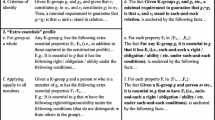Abstract
In this paper I argue for a view of groups, things like teams, committees, clubs and courts. I begin by examining features all groups seem to share. I formulate a list of six features of groups that serve as criteria any adequate theory of groups must capture. Next, I examine four of the most prominent views of groups currently on offer—that groups are non-singular pluralities, fusions, aggregates and sets. I argue that each fails to capture one or more of the criteria. Last, I develop a view of groups as realizations of structures. The view has two components. First, groups are entities with structure. Second, since groups are concreta, they exist only when a group structure is realized. A structure is realized when each of its functionally defined nodes or places are occupied. I show how such a view captures the six criteria for groups, which no other view of groups adequately does, while offering a substantive answer to the question, “What are groups?”
Similar content being viewed by others
Notes
Gabriel Uzquiano (2004) has argued that groups are sui generis entities. For reasons of space I will not address his view here. The four views I examine and the view I develop here all take it upon themselves to give a substantive answer to the question regarding the nature of groups. If a view which gives a substantive answer to that question can be given, I take that to be a mark in favor of it over the view that groups are sui generis.
At least relative to a time and world.
In some video games one can form teams. Depending on what one says about the metaphysics of virtual characters, one might not take such a team to be located in space. However, the most common examples of teams and other groups are located in space.
This criterion goes against the view that two things cannot be in the same place at the same time. For example, David Wiggins notes that “it a truism frequently called in evidence and confidently relied upon in philosophy that two things cannot be in the same place at the same time” (Wiggins 1968, p. 90). I take it that those who take this to be a truism for all things have failed to adequately examine the properties of groups, for groups seem to clearly violate this rule.
I thank an anonymous referee at Philosophical Studies for bringing a case structurally similar to this one to my attention.
This is similar to the explication Sider gives of parthood at a time.
In counterpart theory individuals are usually taken to be world-bound. An individual has many counterparts according to different relations. These relations ground the truth of counterfactual claims. See Lewis (1986).
Coincidence can be captured when two aggregates have different member–components. For instance, suppose there is an aggregate of committees and an aggregate of senators. All and only the individuals in the aggregate of senators are in the aggregate of committees. However, the aggregate of committees has committees, not senators, as member–components. So, the two groups are distinct.
From here I use “catcher,” “pitcher” and the like to mean “the node labeled ‘catcher” and “the node labeled ‘pitcher,’” respectively. I still occasionally use the longer “the node labeled ‘N’” when it makes the discussion more clear.
I thank an anonymous reviewer at Philosophical Studies for comments on the grain of structures and for suggesting the third option discussed here.
Here X is a plural variable. Standardly in plural logic, plural variables allow for something or somethings to be taken as argument. See, for example, Boolos (1984).
References
Benacerraff, P. (1973). Mathematical truth. Journal of Philosophy, 70(19), 661–679.
Boolos, G. (1984). To be is to be the value of a variable (or some values of some variables). Journal of Philosophy, 81, 430–450.
Burge, T. (1977). A theory of aggregates. Nous, 11, 97–117.
Effingham, N. (2010). The metaphysics of groups. Philosophical Studies, 149, 251–267.
Fine, K. (1999). Things and their parts. Midwest Studies in Philosophy, XXIII, 61–74.
Hellman, G. (1989). Mathematics without numbers. Oxford: Clarendon Press.
Lewis, D. (1986). On the plurality of worlds. Oxford: Blackwell.
Putnam, H. (1967). Mathematics without foundations . In: Benacerraf & Putnam (Eds.) (1983). Philosophy of mathematics: Selected readings (2nd ed., pp. 295–311). Cambridge: Cambridge University Press.
Resnik, M. (1997). Mathematics as a science of patterns. Oxford: Clarendon Press.
Russell, B. (1903). Principles of Mathematics. Cambridge: Cambridge University Press.
Shapiro, S. (1997). Philosophy of mathematics: Structure and ontology. Oxford: Oxford University Press.
Sider, T. (2001). Four-dimensionalism. Oxford: Oxford University Press.
Uzquiano, G. (2004). The supreme court and the supreme court justices: A metaphysical puzzle. Nous, 38, 135–153.
Wiggins, D. (1968). On being in the same place at the same time. Philosophical Review, 77(1), 90–95.
Acknowledgments
I would like to thank audiences at the 2011 meeting of the Pacific Division APA and at the University of Texas for valuable feedback on talks based on earlier versions of this paper. In particular, I would like to thank Josh Dever, Kendy Hess, Hans Kamp, Robert Koons, Mark Sainsbury, Nora Berenstain and an anonymous referee at Philosophical Studies for their comments and criticisms.
Author information
Authors and Affiliations
Corresponding author
Rights and permissions
About this article
Cite this article
Ritchie, K. What are groups?. Philos Stud 166, 257–272 (2013). https://doi.org/10.1007/s11098-012-0030-5
Published:
Issue Date:
DOI: https://doi.org/10.1007/s11098-012-0030-5




